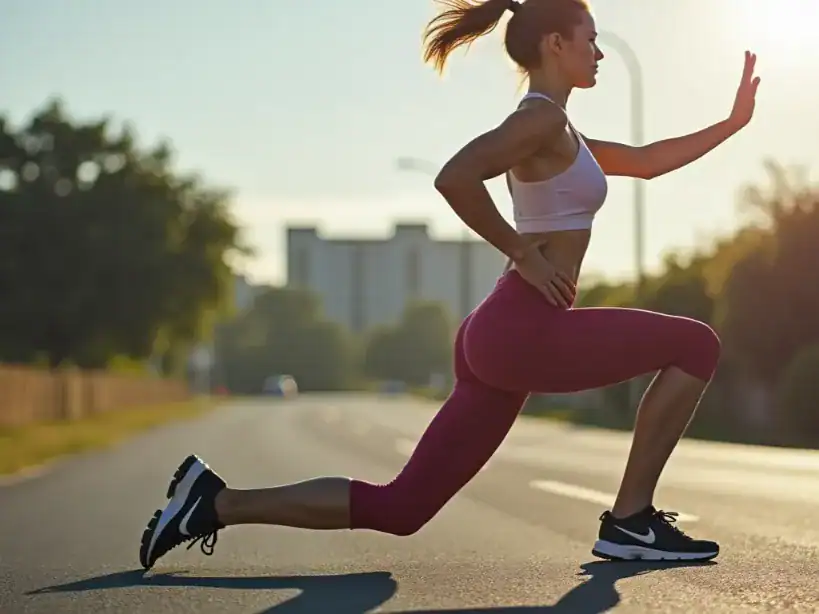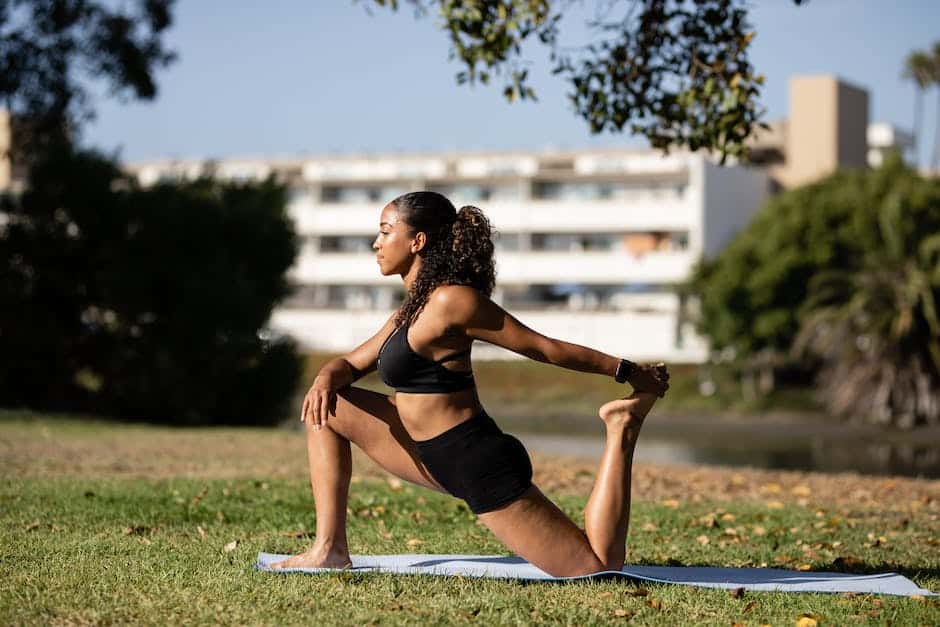Title: 7 Proven Cool-Down Stretches After Running to Prevent Injuries
URL Source: https://gearuptofit.com/running/cool-down-stretches-outdoor-running/
Published Time: 2024-06-24T08:49:23+00:00
Markdown Content:
Skipping your **cool-down stretches** can raise your injury risk by 50%! (Source: American Journal of Sports Medicine). This guide provides essential **post-run stretches** (hamstrings, quads, calves, hip flexors), dynamic movements, and routines to optimize heart rate, improve blood flow, increase range of motion, and minimize muscle soreness for long-term performance.
We’ll break down why it matters, explore the best Running Stretches, and provide you with a plan that will have you feeling refreshed, not wrecked, after every run.

### Key Takeaways:
* **Importance of Cool-Down:** Essential for transitioning from high exertion to rest, reduces injury risk.
* **Heart Rate Recovery:** Gradual decrease aids cardiovascular health, preventing muscle tightness.
* **Boost Blood Flow:** Enhances recovery by flushing out toxins and reducing soreness.
* **Muscle Flexibility:** Incorporates static and dynamic stretches to maintain optimal muscle condition.
* **Injury Prevention:** Regular cool-downs improve flexibility, lowering chances of strains and knee pain.
****Why the Cool-Down is Your Secret Weapon: The Science Behind the Stretch****
——————————————————————————-

Running is like a high-energy play. Your muscles are actors, your heart is the conductor, and blood vessels are stagehands delivering oxygen. During a run, your heart rate and blood pressure rise, causing muscle contraction. Post-run, blood flow increases but waste builds up—like excessive confetti.
A proper cool-down acts as a curtain call, allowing your body to recover for the next performance. Skipping it slows recovery and increases the risk of muscle strains, hindering your long-distance running enjoyment.
This is especially important if you are training with [HIIT for Endurance Athletes](https://gearuptofit.com/fitness/hiit-for-endurance-athletes/).
### ****Here’s the breakdown of the incredible benefits:****

* ****Heart Rate Harmony****: A gradual decrease in heart rate helps your cardiovascular system return to a resting state, improving your heart health. This is a crucial element in reaching optimal performance. If your heart rate stays elevated, you might also experience muscle tightness and feel unwell. It’s about avoiding that fight-or-flight response and returning blood pressure return to normal. This is an important element of [Workout Recovery Techniques](https://gearuptofit.com/fitness/how-to-recover-from-workouts/).
* ****Blood Flow Boost****: The cool-down actively encourages blood flow to the muscles, helping flush out metabolic waste products, reducing muscle soreness after exercise, and facilitating [HIIT for Workout Success](https://gearuptofit.com/fitness/hiit-for-fat-burning-workout-success/). You’re not just relaxing; you’re actively repairing! The more Blood flow improves, the less Pain From Exercise.
* ****Muscle Magic****: Static stretching and dynamic stretches performed during your cool-down help elongate muscle fibers that have shortened during your run. They help maintain a natural muscle structure. This reduces muscle tightness, enhances range of motion, and lowers the chances of muscle strain injuries. This muscle resistance and these steps aid in keeping you in optimal performance. It is important to know [How to Avoid Injuries While Working Out](https://gearuptofit.com/fitness/how-to-avoid-injuries-while-working-out/).
* ****Injury Insurance****: A good cool-down includes stretching exercises to improve flexibility for runners, which, in turn, lowers your risk of injury. It prepares your body for its next workout, prevents any onset muscle soreness and can even help you avoid [Joint Pain and Exercise Safety](https://gearuptofit.com/fitness/tips-for-exercising-safely-with-arthritis-or-joint-pain/).
* ****Mental Calm****: A mindful cool-down can help calm your mind after a challenging run, switching your body from the ‘on’ switch to the ‘off’ switch. It’s like the [Running Mental Training](https://gearuptofit.com/running/running-mental-training/) to get you prepared for your day.
****Building Your Cool-Down Routine: From Walk to Stretch****
————————————————————-
Your cool-down should be a gradual process, like watching the sunset. Don’t just stop running and collapse. Here’s a tried-and-true plan:
1. ****The Gentle Descent (5-10 minutes):**** Begin with a slow walk. This will gently lower your elevated heart rate. This helps your blood pressure return to a normal state and prevent blood to pool in your legs. Consider this your aerobic exercise.
2. ****Dynamic Stretches (3-5 minutes):**** Dynamic stretching focuses on active movements that take your joints and muscles through a range of motion. These are best for warming up cold muscles. This preps your body for the stretching exercises to come.
3. ****Static Stretches (10-15 minutes):**** This is the meat and potatoes, the core component of a great cool-down. Hold each stretch for at least 30 seconds – we’re aiming for a deeper stretch for maximum benefit. Your goal is to achieve flexibility for runners fitness. These stretches are designed to prevent and protect against muscle strain injuries.
****The Stretching Arsenal: Targeted Stretches for Runners****
————————————————————–
Now, let’s target those key running muscles with the following stretches. Each stretch description contains a “visual” to help your body align for the best results:
* ****Hamstring Muscles Stretch:**** The hamstring stretch can be the difference between feeling strong and not getting to that optimal performance level.
* * ****Action****: Lie on your back with one leg extended and the other bent. Slowly bring the straight leg towards your chest, keeping it as straight as possible. You can use a band stretch or a towel around your foot to deepen the stretch.
* ****Feel****: A gentle stretch down the back of your thigh.
* ****Quadriceps Stretch**** (for the front of the thigh)
* * ****Action****: Stand upright, holding onto a wall for balance, feet hip distance apart. Bend one knee and grab your left foot with your hand, gently pulling your heel toward your butt. Keep your knees close together.
* ****Feel****: A thigh stretch in the front of your thigh, focusing on the left thigh.
* ****Calf Stretch**** (for the back of the lower leg): This works the calf muscle and improves flexibility for runners.
* * ****Action****: Lean against a wall with your hands. Step one left foot back, feet flat on the floor, keeping your feet flat. Gently bend your front knee, keeping your back leg straight. Keep your rear foot flat on the ground.
* ****Feel****: A stretch in your left calf and, possibly, a gentle stretch in your Achilles tendon.
* ****Hip Flexor Stretch**** (for the front of the hip): Your Hip flexor stretch is a key element of your recovery workout.
* * ****Action****: Kneel on one knee, feet flat on the floor and the other left foot forward. Gently push your hips forward, feeling the stretch in the front of your hip. Squeeze your butt muscles to enhance the stretch.
* ****Feel****: Stretch in the front of the hip and hip flexors.
* ****Glute Stretch**** (for your buttock)
* * ****Action****: Lie on your back, bend your knees, and keep feet flat on the ground. Cross your left foot over your right thigh. Grab behind your right thigh (or, if you can, hold the front of your right shin) and gently pull your right leg toward your chest.
* ****Feel****: A stretch in your butt muscles.
* ****Adductor Stretch**** (for the inner thigh)
* * ****Action****: Sit with the soles of your feet together, knees bent. Gently press your knees toward the ground. hips square.
* ****Feel****: A stretch in your inner thighs, which are your adductor muscles.
* ****Spinal Twist****:
* * ****Action****: While in a seated position, keep your hips square and your feet flat. Twist your upper body, placing one hand on the outside of your knee and the other behind you for support.
* ****Feel****: Twist in the spine and core muscles.
* ****Overhead Triceps Stretch****:
* * ****Action****: Bring your upper body up and keep your core muscles engaged and your hips square. Bend your arm at the elbow and touch your left shoulder, reaching one hand overhead. Gently pull your elbow towards your head with the other hand.
* ****Feel****: Abs stretch in triceps.
### ****Adding a Dynamic Touch: Mobility and Movement****
After the static stretches, consider some dynamic stretches that can help boost blood flow circulation. These are mobility exercises and are part of a comprehensive fitness routine:
* ****Leg Swings****: Swing your legs forward and backward, and side to side. Don’t force it; keep it controlled. This ensures a full range of motion.
* ****Arm Circles****: Make small circles with your arms, gradually increasing the size. These can release muscle tightness in your upper body.
* ****Hip Circles****: Keeping your feet flat, make gentle circles with your hips to increase mobility and range of motion.
****The Benefits Beyond the Physical: Why It Matters Long Term****
——————————————————————

Embracing the cool-down isn’t just about avoiding immediate pain; it’s an investment in your long-term health and performance. If you incorporate this cool-down routine into your schedule, you might see it pay off with more optimal performance.
It enhances your mobility exercises and your spinal twist. You could also consider adding [Barbell Squats to Your Workout](https://gearuptofit.com/fitness/the-benefits-of-adding-barbell-squats-to-your-set/).
****The Bottom Line: Make It a Habit****
—————————————-
A consistent cool-down routine is the final piece in your running puzzle. It’s a crucial element in your [Fitness Lifestyle](https://gearuptofit.com/fitness/how-to-make-fitness-a-part-of-your-lifestyle/). This recovery workout will lead to [How to Recover From Workouts](https://gearuptofit.com/fitness/how-to-recover-from-workouts/) within the major muscle groups and other key running muscles.
It will also decrease the effects on performance. Make it a non-negotiable part of your post-run ritual and you will experience the benefits. It is a great part of your fitness routine, and one that will keep you on track in achieving optimal running warmups.
****Disclaimer****: Consult with a Physical therapist or other healthcare professionals before starting any new fitness routine and do not take this as medical advice. This content is for informational purposes only.
****References:****
——————-
[1][https://www.runnersworld.com/uk/health/a760484/runners-stretches/](https://www.runnersworld.com/uk/health/a760484/runners-stretches/)[2][https://www.fleetfeet.com/how-to-start-running/how-to-stretch-after-a-run](https://www.fleetfeet.com/how-to-start-running/how-to-stretch-after-a-run)[3][https://www.brooksrunning.com/en_gb/blog/training-workouts/post-run-stretches.html](https://www.brooksrunning.com/en_gb/blog/training-workouts/post-run-stretches.html)[4][https://www.bupa.co.uk/newsroom/ourviews/running-exercises](https://www.bupa.co.uk/newsroom/ourviews/running-exercises)[5][https://www.runnersworld.com/uk/training/beginners/a32172701/how-to-stretch-post-run/](https://www.runnersworld.com/uk/training/beginners/a32172701/how-to-stretch-post-run/)[6][https://www.nhs.uk/live-well/exercise/how-to-stretch-after-exercising/](https://www.nhs.uk/live-well/exercise/how-to-stretch-after-exercising/)[7][https://www.adidas.com/us/blog/533568-the-best-stretches-for-runners-to-warm-up-and-cool-d](https://www.adidas.com/us/blog/533568-the-best-stretches-for-runners-to-warm-up-and-cool-down)
[own](https://www.adidas.com/us/blog/533568-the-best-stretches-for-runners-to-warm-up-and-cool-down)[8][https://www.verywellfit.com/essential-post-run-stretches-2911936](https://www.verywellfit.com/essential-post-run-stretches-2911936)[9][https://www.youtube.com/watch?v=taiBlDZhFT4](https://www.youtube.com/watch?v=taiBlDZhFT4)[10][https://www.newbalance.co.uk/running-advice/training/beginners-guides/cool-down-stretches-after-running/](https://www.newbalance.co.uk/running-advice/training/beginners-guides/cool-down-stretches-after-running/)[11][https://www.piedmont.org/living-real-change/the-5-most-important-post-run-stretches](https://www.piedmont.org/living-real-change/the-5-most-important-post-run-stretches)[12][https://www.nike.com/a/stretches-after-running](https://www.nike.com/a/stretches-after-running)[13][https://www.youtube.com/watch?v=x30WqnqET1c](https://www.youtube.com/watch?v=x30WqnqET1c)[14][https://www.youtube.com/watch?v=FbmLx-PahO4](https://www.youtube.com/watch?v=FbmLx-PahO4)[15][https://www.youtube.com/watch?v=RtO-EDVQpgI](https://www.youtube.com/watch?v=RtO-EDVQpgI)[16][https://www.youtube.com/watch?v=MCf2QDOsy0E](https://www.youtube.com/watch?v=MCf2QDOsy0E)

STRICTLY RETAIN HTML FORMAT. DO NOT ADD TITLES. DO NOT ADD SIGNATURES. DO NOT ADD ‘LEAD DATA SCIENTIST’. JUST FIX GRAMMAR AND FACTS.
**ACTION:** Surgically polish this section. Inject missing semantic keywords. Update facts. DO NOT ADD A TITLE OR SIGNATURE.
